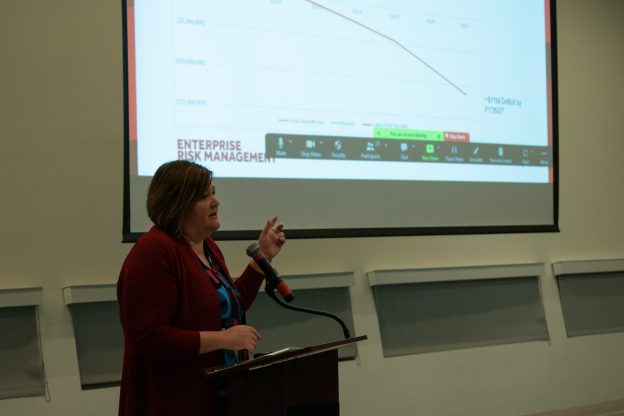
For an hour on Wednesday, Feb. 15, a small band of students tried to make their voices heard at Stony Brook University’s West Campus fountain — nearly a week after the Mobility and Parking Services (MAPS) proposed to switch to a fully-paid parking model in August 2023.
“I honestly don’t think I can pay for this,” Chris Clarke, a junior physics major and commuter, said. “I know I didn’t come [to SBU] because I was rich and wealthy and could go anywhere I wanted.”
Holding up the rallying call during the protest, Clarke was impressed by a turnout he thought was “spontaneous.”
“I think it just goes to show how this didn’t have to be organized or orchestrated for it to be this big, especially because it was orchestrated just a few days ago,” Clarke said.
Following an email sent to students by MAPS on Feb. 10, which outlines plans to rehaul the parking process for students, many went to social media to voice their concerns.
Currently, MAPS is looking to convert all spaces on campus to an all-paid parking model, with the removal of faculty and student designated lots in favor of a tiered system. Parking would be first-come-first-serve to all individuals who buy into a specific parking zone.
A user on the Stony Brook University chat forum r/SBU quickly organized a protest to be held in front of the Administration building. The post reached over 800 accounts after it was reposted by a popular university fan-page on Instagram.
But despite such digital uproar, barely 30 students showed up to the actual gathering.
View this post on Instagram
Users took this disappointment back online after pictures of the crowd size were posted.
“Reddit all talk no show as usual,” one user said. “More cops than protestors.”
But the smaller crowd size didn’t deter the few that marched into the Administration building and voiced their concerns, arguing that the recent parking proposal only exacerbates current economic woes for low-income and graduate students.
“I can barely get a job with the course load I already have, and they took away my scholarship because apparently I’m not doing enough, and now they’re expecting me to pay for the privilege of parking here, just how they’re expecting graduate students to pay for the privilege of working here,” one student told the crowd at the rally.
More students became energized once they were allowed into the Administration building under the supervision of Dean of Students Ric McClendon. McClendon declined to comment about the situation to The Statesman.
“You know what happens when you turn 26?” one student pressed to the group. “You lose your insurance. Which means I’m now on means-tested insurance. I have to make below the poverty line … this fee will affect me.”
One of the biggest concerns brought about by the crowd was the lack of transparency and representation during the planning process of the new fee.
“We want to know what we’re paying for and what we’re going to be getting,” Anthony Amador, a sophomore civil engineering major, said.
“The real issue is where it’s coming from: our wallets,” Clarke said. “It’s insane to me that the administration has been going through all these policies that burden us, that increase our pay, without any kind of democratic decision making from us. USG can only do so much.”
Parking changes themselves weren’t the issue for Clarke. When MAPS pushed for students to use Lot 40 as a free option to commuters, Clarke was initially receptive.
“It meant that I didn’t have to go into these different entrances to find parking lots. It wasn’t a race,” he said. “But with these changes, I don’t know how long I’ll be able to be on campus … it’s almost as if I’m being disincentivized to be on campus. As soon as my classes are done, I’m gonna leave.”
Others have always felt shafted by the University’s parking decisions. Amador, whose commute spans over an hour each day, has faced multiple hurdles trying to find a spot.
“[Lot 40] is 15 minutes away, and it’s very reclusive. It’s not a great area to park, and now they want us to pay for it after we’ve been parking there for free?” Amador said.
“It’s just ridiculous,” Julio Alves, a senior history major who faces a similar commute, said. “If they’re gonna charge us for up to $150 for a parking lot that’s 15 minutes away and a bus ride from main campus; f— that.”
For the two students, these new increases are hitting a breaking point.
“I’m just gonna take the LIRR,” Amador said. “I’m not even gonna pay for parking.”
While Alves and Amador were more pessimistic about the protest as a whole, Clarke remained hopeful, and his work was not done. As a member of the College Socialists at Stony Brook University, he has begun to reach out to other research universities in the SUNY system to coordinate a state-wide protest against Governor Kathy Hochul’s proposal to increase tuition rates by 30% over the next five years.
The group also is creating a petition to eventually send to President Maurie McInnis about the parking prices.
“Continue protesting, continue agitation and continue outrage,” Clarke said.

“There’s not enough money to cover what we do,” MAPS tells USG Senate
On Thursday, Feb. 16, the Undergraduate Student Goverment’s (USG) weekly senate meeting hosted Kendra Violet, executive director of MAPS.
One of the first questions pressed to Kendra Violet was from Clarke. “Why haven’t there been explored alternatives to fund [parking] through administration over the past five years? Infrastructure hasn’t been doing well,” Clarke said, citing Violet, as she previously mentioned in a 30-minute presentation how parking spaces are struggling to be maintained under the current system.
“Some of you are parking in lots where we can’t even paint the lines, because the surface is actually crumbling,” Violet said. “There’s not enough money to cover what we do.”
MAPS took the time at the weekly Senate meeting — moved to the Alan S. DeVries Center for high turnout — to present a similar presentation to what the department showed campus stakeholders and administrators earlier this month.
In a survey presented at the meeting, conducted by an outside agency for MAPS in the 2019-2020 academic year, over 45% of respondents — including 42% of students and 52% of faculty and staff — reported negative or strongly negative experiences with Stony Brook parking. In another survey conducted by The Statesman in 2021, almost 70% of respondents did not approve of the University’s parking and traffic conditions.
As of 2022, nearly 71% of students have negative or dissatisfactory views on the current parking model, according to USG’s released survey results from the fall of 2022, and 61.5% of students surveyed disapproved of Commuter Student Premium Parking.
The high dissatisfaction of parking conditions compounded the need for higher expenditures on maintenance and projects, leading to the new parking plan.
“Garages won’t last forever,” Violet said. “They need to be replaced. We have capacity issues on our East Campus. That needs to be addressed.”
With the higher costs came another issue: debt. As an Income Fund Reimbursable (IFR) account, all of MAPS’ revenue goes directly towards its expenses. The $210 transportation fee students pay each semester only goes towards direct transportation services, such as the shuttle buses and transit lines. This left little to no money to work on any other projects with the current revenue stream.
“If we made no changes at all in the next five years, we’re going to end up with an $11 million deficit,” Violet said.
The Mobility and Parking Services, formally created in the fall of 2022 after combining the parking and transportation services on both East and West campuses, looked at multiple options on how to address the economic and public needs. The implementation of new technologies, such as license-plate detection, vehicular guidance and an expanded database for University Police and Parking Enforcement, along with continued operational costs with maintaining two large campuses, all converged on one commonality: fully-paid parking.
“Why is this policy being made now instead of at any other time?” Senator Yuchen Zhang said, calling out the service for not keeping up with inflation rates for the past 30 years of having the parking system.
“They’ve been able to operate as they had done,” Violet responded.
Violet was met with more questions than anticipated, with the meeting lasting almost a full 90 minutes.
“Students are already struggling to afford meal plans, tuition, plus the tuition increase SUNY is proposing of 6% each year,” Amanda Basinger, president of the College Socialists, said. “How do you expect students to be able to pay for this if they’re already struggling to make ends meet?”
“What would you say to a low income student who, for example, was unable to pay for parking and one who was not able to use FAFSA to pay for parking as well,” Garett, a student who was yielded time by Senator Aliaksandra Kiniova, said.
Senator Kiniova had her own questions regarding their negotiation process.
“When I received [MAPS’] email on [Feb. 10], it said the details of this system were shown with campus stakeholders, including representation from our various unions and student government. Well, I’m in student government — I’m a senator — and this was the first time I ever heard about this,” Kiniova said. “What makes me concerned is that if you want to work with us and USG, why wasn’t I invited to the conversation?”
Other students came with questions and disdain not only directed towards MAPS, but toward the administration as a whole.
“My name is Anthony. I don’t really have a question. I just want to say I feel like you’re throwing students under the bus in the fact that you’ve moved a lot of residents to places that students have to walk sometimes up to a half mile. And the fact that they get to pay for that is kind of outrageous.”
Jeff, a graduate student in their final semester, hoped to get in the last word. “None of this affects me at all, but what I am affected by is inequity; I think this plan is inequitable.”
MAPS currently has no plans to backtrack on its current proposals, but the new parking plan isn’t finalized. But, the move to fully paid parking seems more concrete than ever before.
Sonya Gugliara contributed reporting.






















